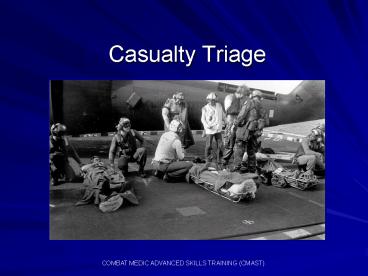Casualty Triage PowerPoint PPT Presentation
1 / 27
Title: Casualty Triage
1
Casualty Triage
COMBAT MEDIC ADVANCED SKILLS TRAINING (CMAST)
2
Introduction
- Familiarity with the principles of casualty
triage. - Perform casualty triage in a given situation.
- Understand patient triage vs. evacuation
categories.
3
Casualty Triage
- Mass casualty (MASCAL) situations occur when the
number of casualties exceeds the available
medical capability to rapidly treat and evacuate
them. - The actual numbers varies depending on available
resources - May be a soldier medic having to manage more
than one casualty at a time
4
Casualty Triage
- System used for categorizing and sorting
casualties according to severity of their
injuries and available resources - Survey and classify
casualties for the most
efficient use of available
medical personnel and
supplies
5
Casualty Triage
- Treatment first towards the casualties who have
the best chance to survive - Locate troops with
minor wounds and
return them to duty
6
Casualty Triage
- Determine the tactical and environmental
situation. - Necessity to transport casualties to a more
secure collection point for treatment. - Number and location of injured.
- Severity of injuries.
- Available assistance self-aid, CLS, medical
personnel. - Evacuation support capabilities and requirements.
7
Casualty Triage
- Establishing triage, treatment and holding areas.
- May be established in existing MTF, an available
shelter or outdoors
8
Casualty Triage
- Existing MTF for MASCAL stations
- Triage area
- Easily accessed
- Sufficient space
- Controlled flow
- Surgical detachment
- Holding areas for each triage category
- Marking (casualty triage tags)
9
Casualty Triage
- Outdoor MASCAL stations
- Overhead cover available shade
- Triage area accessible
- Outdoors
- Inclement weather
planned for - Improvised shelters
- CBRN threat?
10
Casualty Triage
- Triage is the process of prioritizing soldiers on
the basis of their individual needs for medical
intervention. - The likely outcome of the individual casualty
must be factored into the decision process prior
to the commitment of limited resources.
11
Casualty Triage
- Casualties are generally sorted into the
following four categories (or priorities). - Remember Triage is an ongoing process of
reassessment which may change the casualties
triage category.
12
Casualty Triage
- Sort multiple casualties into priorities.
- Conventional battlefield casualties.
- Immediate immediate treatment to save life, limb
or eyesight - Delayed casualties who have less risk of losing
life or limb - Minimal walking wounded", self-aid or buddy-aid
- Expectant casualty so critically injured that
only complicated and prolonged treatment offers
any hope of improving life expectancy
13
Casualty Triage
- Integrated battlefield casualties.
- Immediate conventional life threats no CBRN
- Chemical Immediate severe chemical life threats
no conventional threat - Delayed no conventional life threats mild
chemical threat - Minimal minor conventional injuries no chemical
- Expectant conventional life threats severe
chemical threat
14
Evacuation Categories
- Evacuation Urgent.
- Evacuation required as soon as possible no later
than 2 hours to save life, limb or eyesight. - Casualties condition(s) cannot be controlled and
have the greatest opportunity for survival - Cardiorespiratory distress
- Shock not responding to IV therapy
15
Evacuation Categories
- Evacuation Urgent (contd).
- Prolonged unconsciousness
- Head injuries with signs of increasing ICP
- Burns covering 20 to 85 of TBSA
16
Evacuation Categories
- Evacuation Urgent Surgical.
- Evacuation required for casualties who must
receive far forward surgical intervention to save
life and stabilize for further evacuation. - Decreased circulation in the extremities
- Open chest and/or abdominal wounds with decreased
blood pressure - Penetrating wounds
17
Evacuation Categories
- Evacuation Urgent Surgical (contd).
- Uncontrollable bleeding or open fractures with
severe bleeding - Severe facial injuries
- Burns on hands, feet, face, genitalia or
perineum, even if under 20 TBSA
18
Evacuation Categories
- Evacuation Priority.
- Evacuation is required within 4 hours or
casualtys condition could become worse
and become an "urgent" or "urgent surgical"
category condition. - Closed-chest injuries
- Brief periods of unconsciousness
- Soft tissue injuries and open or closed fractures
19
Evacuation Categories
- Evacuation Priority (contd).
- Abdominal injuries with no decreased blood
pressure - Eye injuries that do not threaten eyesight
- Spinal injuries
20
Evacuation Categories
- Evacuation Routine.
- Evacuation required within 24 hours for
casualties requiring additional care. - Simple fractures
- Open wounds including chest injuries without
respiratory distress - Psychiatric cases
- Terminal cases
21
Evacuation Categories
- Evacuation Convenience.
- Evacuation of casualties by medical vehicle is a
matter of convenience rather than necessity. - Minor open wounds
- Sprains and strains
- Minor burns under 20 of TBSA
22
Medical Evacuation Request
23
Medical Evacuation Request
- Prepare a standard nine-line Medevac request.
- Line 1 Pickup location
- Line 2 Radio frequency, call sign and suffix
- Line 3 Number of casualties by precedence
(evacuation) category - Line 4 Special equipment
required - Line 5 Number of casualties
by type (ambulatory vs. litter)
24
Medical Evacuation Request
- Prepare a standard nine-line Medevac request.
- Line 6 Security of pickup site (wartime) or
number/type of wounded, injured, illness
(peacetime) - Line 7 Method of
marking pickup site - Line 8 Casualtys
nationality and
status
25
Medical Evacuation Request
- Prepare a standard nine-line Medevac request.
- Line 9 NBC contamination (wartime) or terrain
description (peacetime) - NBC contamination, if any - otherwise omit this
line - Terrain description including details of terrain
features in and around proposed landing site - As a minimum, the first five items must be
provided in the exact sequence listed.
26
Summary
- A firm understanding of triage will help the
soldier medic maximize resources and reduce
complications. - Identify steps in performing triage.
- Perform a triage in a given situation.
- Identify triage categories.
- Identify evacuation categories.
27
Questions?

